| |
|
Lost Sword of a Civil War Hero |
|
Colonel Robert Gould Shaw
Commanded the American Civil War’s 1st 'Black
Regiment' |
|
Colonel Robert Gould Shaw (Died
1863)
54th Massachusetts Infantry |
1863 - Colonal Robert Gould Shaw led the 54th Massachusetts
Infantry, the Civil War’s first all-black regiment, into battle in South
Carolina. Shaw carried a sword, and when he was killed in battle, that
sword disappeared. Two years later, it was rediscovered and given to his
parents. But then, in the course of time, it was lost again.
Turns out, it was sitting in an attic in Massachusetts’ North Shore, not
far from Boston. Recently, descendants of Shaw’s sister were sorting
through attic storage, when they came across a sword. |
|
Colonel Robert Gould Shaw's Sword
There are Three Initials on the Sword: RGS |
| The family has now handed this relic over to the Massachusetts
Historical Society, along with family papers and letters, photographs,
and other artifacts. The sword is the highlight of the collection. It
is, says the society’s curator, “a magnificent specimen of a sword…
exactly what a colonel would carry in a war.” |
|
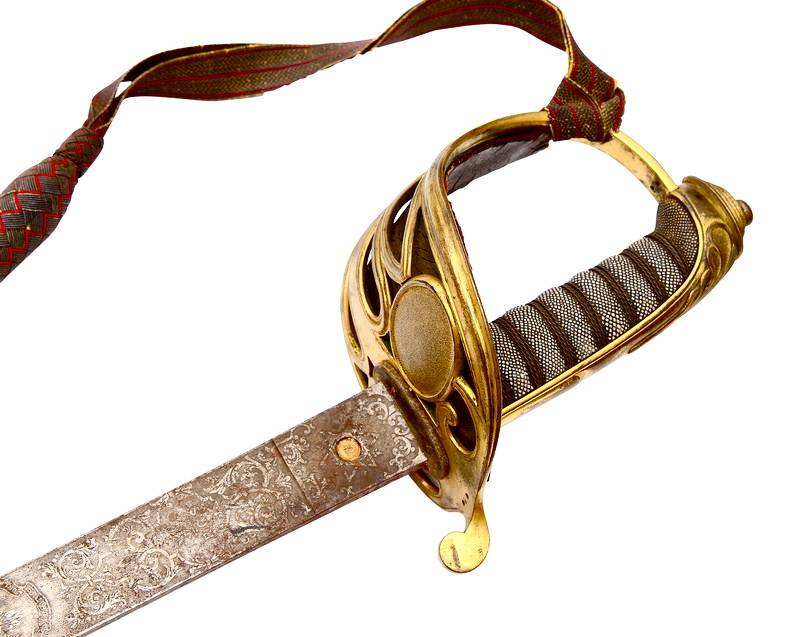 |
With the American Civil War soon to be entering its third year, and
the ranks being depleted due to battlefield casualties and desertions,
the Union army was in great need of new recruits. By the end of January
1863, Lincoln authorized Secretary of War Edwin M. Stanton to allow
black men to enlist in volunteer regiments. Though the idea of arming
black men was controversial and unpopular among many white soldiers and
citizens, this move found great favor amongst the abolitionists with
whom the topic already had been discussed.
Pro-abolitionist Governor John A. Andrew of Massachusetts executed his
plan to form a black volunteer regiment. This unit, the 54th
Massachusetts, would be the first of its kind in the Northern states.
Governor Andrew approached Shaw to lead the new regiment as its colonel,
because of his family's powerful and respectable status in society and
their principles on anti-slavery.
Shaw organized and drilled the recruits at Camp Meigs near Boston. As a
commanding officer he was a strict disciplinarian, largely out of his
concern that the failure of this experimental regiment would bring
ridicule and shame to all, damaging future chances for more regiments of
its kind. |
|
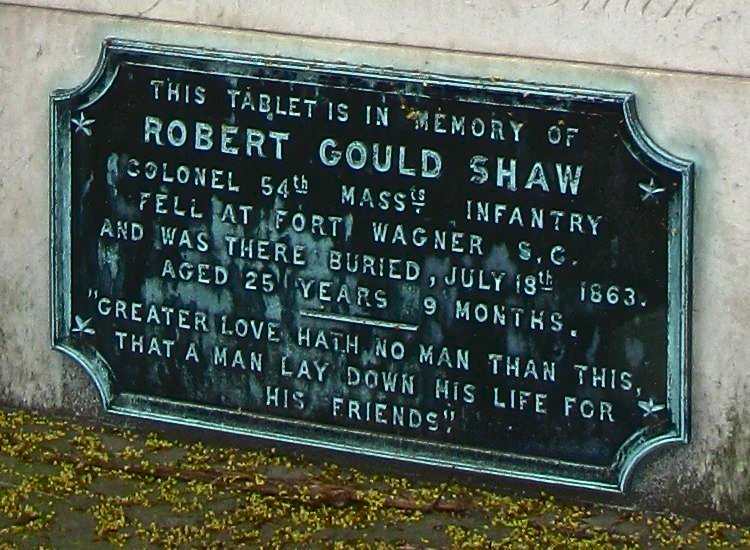 |
|
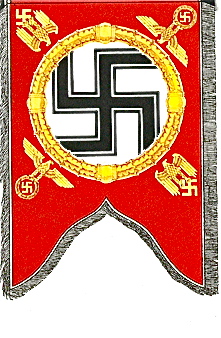 |
 |
|
Solingen the "City of Swords" - Located in the former Rhine
Province of Prussia on the Wupper River. For centuries Solingen has been
the heart of the German edged weapon and cutlery industry.
Solingen - Is one of the most renowned of all the ancient cities
that created fighting blades for the armies of Europe. It ranked with
Toledo and Damascus, and the quality of its weapons was held in high
regard by warriors of many lands.
Even Today - Solingen remains as one of the world's largest
manufacturers of swords, knives and cutlery.
The Solingen Sword Industry - Received considerable impetus
around the year eleven hundred and thereafter from the "Knights of
Saint John of Jerusalem". These noble warriors established many
manors and castles in the area around Solingen, and readily availed
themselves of the fighting weapons from the Solingen forges.
During the Crusades - Many Solingen sword makers accompanied the
noblemen and knights, to whom they pledged allegiance, into foreign
lands in ventures of conquest. This enabled them to observe firsthand
the practices and techniques employed by the foreign sword producers.
When the swordsmiths returned to their forges in Solingen after the
wars, they incorporated all their newly learned skills into the weapons
they created.
1933 Nazi Germany - A New Fuehrer and a Third Reich
Not since the Crusades had Solingen been so revitalized, as by the Third
Reich in 1933. |
|
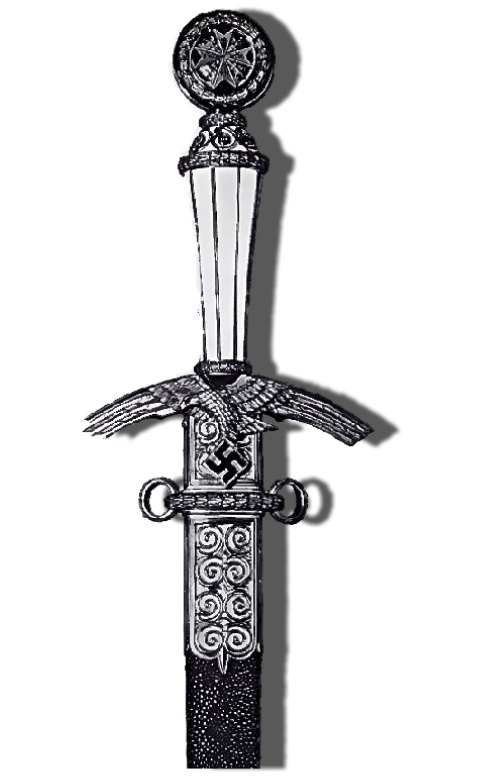 |
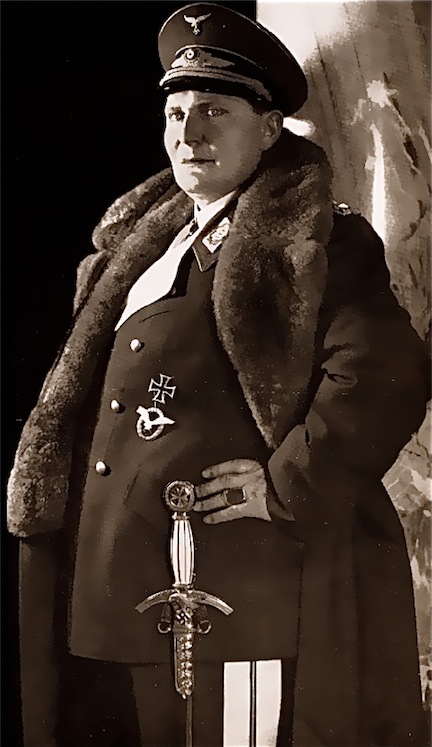 |
|
Hermann Goering - Wedding Sword |
Hermann Goering - Wearing Wedding Sword |
|
Goering was the Commander-in-chief
of the German Luftwaffe (Air Force) |
| Hermann Goering - Was instrumental in furthering the adoption
of many new daggers and swords for the Third Reich, and personally
contributed to the design of several pieces. Goering was seldom seen
without a dagger or sword of some fashion, on his belt. |
|
Luftwaffe Generals Sword |
Luftwaffe Officers Sword |
|
 |
Swords - Employed by warriors centuries ago were reproduced
in exact form and design for the soldiers of Hitler's German military.
Many of the Third Reich designs for swords were copied from the medieval
arms carried by the Teutonic forbears of the leaders of the Wehrmacht.
Swords produced by Germany in the 1930's were principally for purposes
of tradition and prestige, and were not designed for incapacitating
enemies of the Reich.
Throughout History - Swords have been regarded as symbols of
independence, strength, justice and valor. After 1650 however, swords
lost much of their significance as weapons of warfare, and assumed more
importance as a symbol of authority and rank. Size and fighting weight
were reduced and virtually every royal ruler and military leader adorned
himself with an elegant blade.
Officers and noncommissioned officers of the German military forces have
traditionally carried swords. This tradition was extended into the
Hitler era, however, daggers were more predominant than swords.
Variety of Designs - Encountered among German swords of the Third
Reich is almost limitless. Several models had their origin in the
Imperial Era, and with minor modification, were produced for the leaders
of the Nazi forces.
Except for the SS Officer's Sword, all Nazi swords could be purchased
from the manufacturer of the individual purchaser's choice. Swords were
ordered either from retail stores dealing in cutlery and edged weapons,
or else from Solingen firm salesmen who regularly visited the military
camps to take orders.
It is quite obvious that members of the elite SS developed much more
tradition, and exercised tighter controls with regard to wearing their
daggers and swords, than did the other Nazi organizations. |
|
Nazi German Army - Officers Swords
Color Illustrations |
|
Original Printing Plates - Firms of Holler and WKC
(Solingen) |
|
Army Officers Sword - Silver Plated Wehrmacht
Emblem
Model: Also comes with Gold Plated Eagle |
|
Common Pattern - Army Officers Sword with Red
Jeweled Eyes
Sword Grips - 'Gold Plated, Hand Polished and Lacquered'
or 'Sprayed with Gold Paint'
(Choice of Finish Determined the Price) |
|
Unusual Design - Army Officers Sword
Patented by F. W. Holler
New Sword Designs were Originated by Firms & Approved by the Army |
|
Army Officers Sword - Designed for Cavalry or
Artillery
Crossed Swords for Cavalry - Crosse Cannons for Artillery
No Swastika on this Particular Model |
|
Standard Army Officers Sword with Hand Polished
Finish |
|
2,300 Years Old
Chinese Sword is Still Shiny! |
|
Amazing Discovery was made in an
'Ancient Tomb' in Xinyang City
Central China's Henan Province |
| The Sword - Is thought to come from the time of the
Warring States, which was a period of 250 years between 475 BC and
221 BC, which saw numerous fierce wars fought between the eight states
of the Zhou Dynasty. |
|
Millennia-old Weapon Looks Sharp - Is Still
Glistening - As an Archaeologist Pulls it from its Sheath |
Archaeologists - Discovered the ancient weapon, in a tomb
among the ruins of Chengyang City in central China.
When they unsheathed the large blade from its muddied cover, they found
it had not oxidized but was still sharp, shiny and in near-perfect
condition.
The Sword - Had been buried inside a wooden coffin next to its
owner. It had been preserved because ancient tombs in the area are
usually humid and sealed off from the outside.
The owner of the tomb in the city in the ancient Chu kingdom, located
25km north of Xinyang city in Henan Province, has not yet been
identified. |
|
Chinese Man Finds Ancient Sword in
Ground |
|
Experts Think the Sword Dates to the
Ching Dynasty
Because the Characters 'Ching Lung Jian' are Etched into It
Meaning: "Green Dragon Sword" |
A 60-year-old Chinese farmer who found an
ancient sword blade digging in the ground used it as a kitchen knife for
several years before realizing its value and historical importance. He
may have disallowed efforts to determine its exact age by polishing and
sharpening it.
Government officials became aware of the sword while visiting his
village in a bid to find items of historical value to put on display.
The officials contacted the local cultural bureau to determine the
sword's historical value. |
Such swords are still used today in Tai Chi training, a form of
exercise and a Martial Art. The double-edged straight sword, or Jian,
goes back 3,000 years. Before the Iron Age, Jian swords were made of
bronze and were shorter. But about 2,000 years ago sword makers began to
use iron and steel. The length of the Jian swords increased gradually.
Jian blades became more refined and more popular among Martial Artists
and martial arts Societies beginning in the Ming Dynasty (1368-1644) and
the Ching Dynasty (1644-1912). Most antique Jian swords one sees
nowadays are mid to late Ching Dynasty blades. Excellent swords were
also made in China's Republican era until 1920 or later.In 2014, a
boy was washing his hands in the Laozhoulin River in Gaoyou County,
China, when he felt something hard and metallic. He pulled out the
object and found that it was a rusty sword—a 3,000-year-old bronze
piece. |
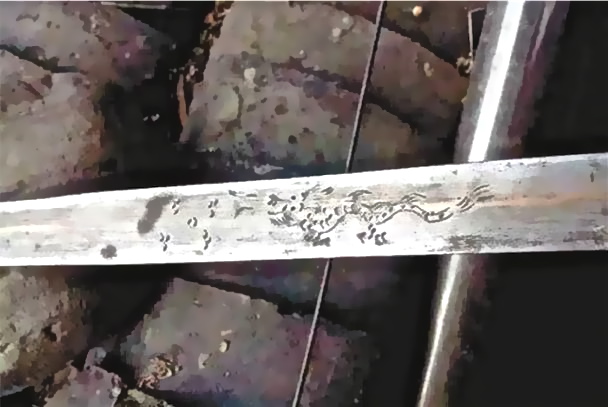 |
 |
After fishing the sword out from the river, the boy took the relic
home to his father. As news spread around their town, locals began
flocking to their home, with some offering high prices to purchase the
artifact. However, the boy and his father felt it was best to preserve
the sword for its cultural value and sent it to the Gaoyou Cultural
Relics Bureau, who rewarded the two for their honor in protecting and
donating it.
The Relics Bureau organized a team of local cultural relics experts to
identify the sword. Initial identifications found that the bronze sword
could be dated back to around the time of the Shang and Zhou dynasties,
more than 3,000 years ago. It is among the oldest swords ever recovered.
The first bronze swords are believed to have first been developed in
China around 3,200 years ago. |
|
Chinese Bronze Sword Blade (similar Laozhoulin
River) |
|
| The Bronze Sword which does not have decorative patterns, is
an example of a Short Sword, which was often used by civil
officials for decorative or status reasons. Swords of this period were
typically made from bronze with high tin content for the cutting edge
and bronze with low tin content for the spine, resulting in a sword with
hard and durable cutting edges and a flexible spine to absorb shock.
There was also extensive use of copper sulfides as anti-corrosion
coatings. |
|
India’s
Deadly - Flexible Whip Sword |
|
Called the Urumi
A Sword that "Acts like a Whip"
It will cut you! |
|
The Urumi hasn’t regularly been used as an actual
weapon for generations.
But even as a demonstration weapon, it is still incredibly dangerous.
Especially to the user! |
|
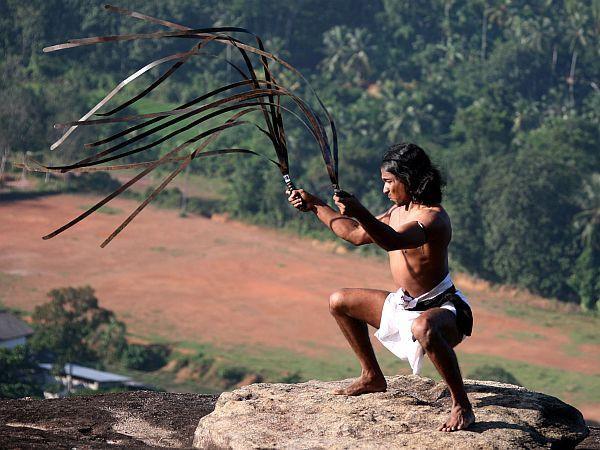 |
Urumi - Can be translated as
“Curving Sword” and is also known as a “Chuttuval”. It hails
from Southern India. The historic weapon was saved from the
erasure of time when it was incorporated into Kalaripayattu martial
arts, an Indian fighting style that is considered one of the oldest in
the world. Incorporating elements of yoga and performative dance,
Kalaripayattu movements look like violent but graceful choreography.
Urumi fighting is no different, it is just far more dangerous to those
who would attempt to learn the skill.
Like any sword, the Urumi comes in a number of varieties, with a
variable length, and even a variable number of blades, but they all
follow the same basic construction. Usually simpler than more
elaborately decorated sword weapons, at its simplest, the Urumi consists
of a hilt connected to a thin, flexible steel blade. The handle is
usually protected by a crossguard and knuckle-guard'. The long blades
extend somewhere between four and six feet in length (or even longer in
some cases), and around an inch in width, but the aspect that makes the
weapon unique is that the steel is always thin enough to flop around.
Given the Urumi's unique construction, wielding it is also an art unto
itself. Since the flexible blade is no good for stabbing, it is slung
around similarly to a traditional leather whip. In order to make
continuous strikes with the weapon, it must stay continually in motion
so that the momentum which gives the blade its slashing power is not
lost. This usually requires the user to swing it over and around their
head and shoulders in furious arcs.
While this makes the Urumi incredibly hard and dangerous to use, it also
provides it with one of its major benefits as a weapon. When the blade
curves around the sword wielder in quick arcing slashes, it creates a
defensive bubble of flying metal that an opponent would be reckless to
get close to. In addition, it makes a terrific weapon for defending
against multiple opponents, both by providing a good barrier at a number
of angles at once, and for the long, wild attacking arcs the steel whip
provides. |
|
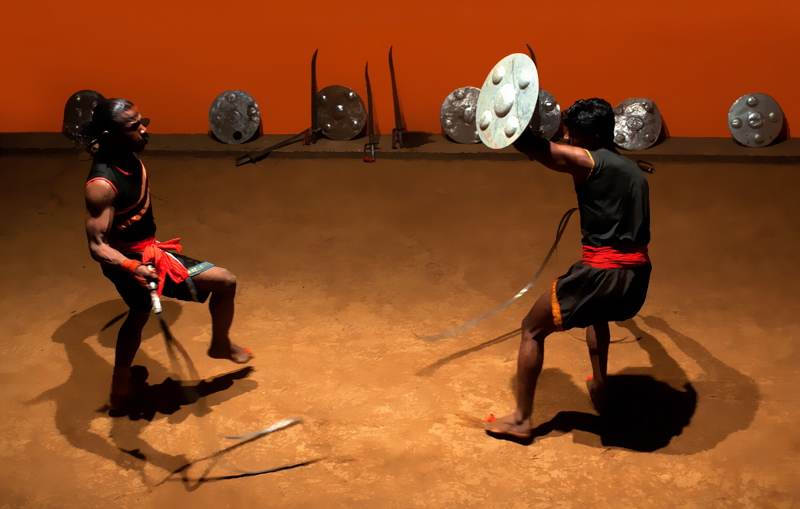 |
Urumi Sparring - Incorporates small 'Buckler
Shields' that are used to deflect direct swings of the weapon, but
when the Urumi was used in actual combat, it was said to have had the
added benefit of curving around the edges of enemy shields, landing cuts
even when blocked.
Added Bonus of a Wildly Flexible Blade - The Urumi could be
tightly rolled up for easy travel and concealment. In fact, it has often
been worn as a belt.
Of course all of this versatility comes at a price. As you can imagine,
winging metal whips around your delicate face flesh at high speeds can
easily result in a missing nose, or other mishap. Wielding the urumi
correctly and safely takes years of training, learning techniques for
everything from bringing the blade to safe stop, to altering the
rotation of your swings without slicing your arm off.
In the hierarchy of Kalaripayattu weapons training, the Urumi is usually
taught last due to the high degree of difficulty in wielding the weapon.
Sometimes, students begin their training using a piece of cloth instead
of the metal blade, so that they can master the intricate moves of the
Urumi before picking up any steel, learning a graceful flow and rhythm
to their swings.
All of this training is required to wield an Urumi that has only one
blade, however many variations of the weapon have multiple steel belts
radiating from the handle like a slashing flog. Without question, the
more strands on a given Urumi, the more difficult it becomes to wield,
but the more deadly it becomes to the opponent. According to one source,
there was a Sri Lankan version of the Urumi that had 32 blades, and was
usually double-wielded, with one in each hand. |
|
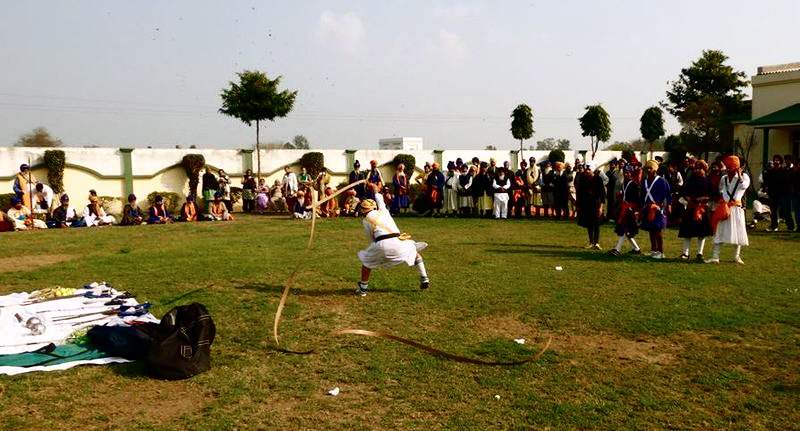 |
| Urumi weapon still springs up in popular culture from time to time.
The weapon can be found in tabletop roleplaying games like Pathfinder,
and Urumi-wielding warriors can be summoned as troops in the 2007
strategy game Age of Empires III: The Asian Dynasties. There was even a
2011 Indian historical drama called, Urumi, which prominently featured
the main character using the weapon. |
|